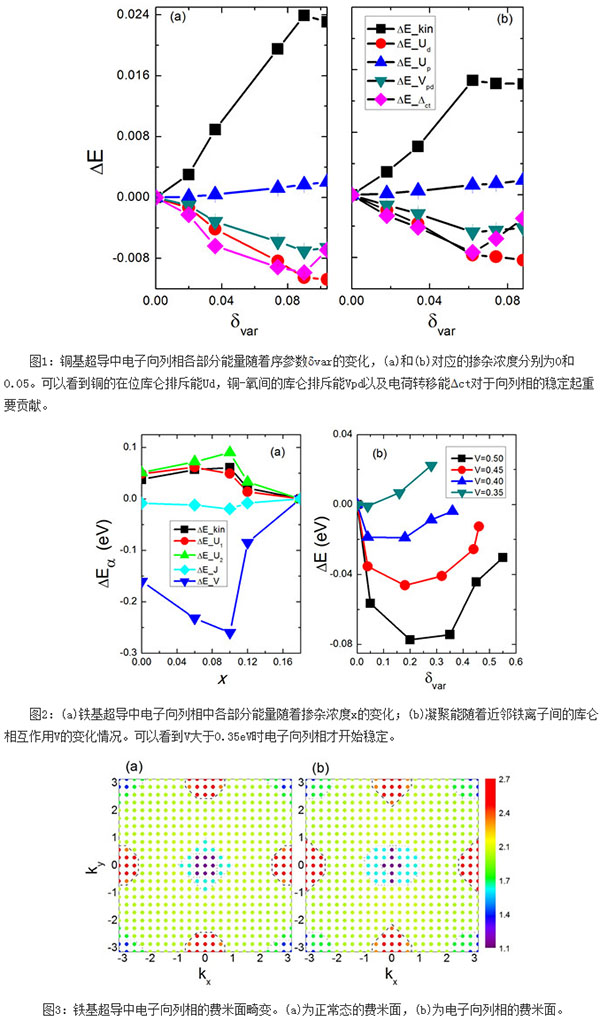Recently, researcher Zou Liangjian of the Research Institute of Solid State Physics at the Chinese Academy of Sciences’ Hefei Institute of Physical Science has made a series of progresses in the electron nematic phase studies of copper-based and iron-based superconducting materials. Relevant results were published in Journal of the Physical Society of Japan (2014, 83, 024705), Chinese Physics. B (2015, 24, 017404), Physical Review B (2015, 92, 085109). Among the articles published in Chinese Physics. B were selected from National Science Review, Volume 2, Issue 3. Pp 253-254. The electron nematic phase is a more exotic electronic phase commonly found in copper-based and iron-based superconducting materials. In the electron nematic phase, the 4-fold rotational symmetry of the system is destroyed, and the translational symmetry is preserved. In a copper-based superconducting material, the phase transition temperature of this electronic phase is the same as the initial temperature of the èµ energy gap, and therefore it is understood that the mechanism plays a key role in explaining the èµ-gap phenomenon of copper-based superconductors. In iron-based superconducting materials, it begins above the antiferromagnetic transition temperature and the structural transition temperature, and is adjacent to the superconducting phase. Understanding the mechanism of its formation helps to understand the mechanism of superconductivity in iron-based superconductors. However, so far, its microscopic physical mechanism is still in dispute. In order to reveal the microscopic physical mechanism of the electron nematic phase, the researchers used the quantum variational Monte Carlo method to study the multi-band Hubbard model based on copper-based and iron-based materials. In copper-based materials, it has been found that the electron nematic phase can be completely driven by electron-electron correlation, in which the in-situ Coulomb repulsion energy of copper ions in the copper oxygen plane, the Coulomb repulsion energy between the adjacent copper and oxygen ions are all Which plays an important role. In iron-based materials, it has been found that the Coulomb interaction V between the nearest neighboring iron ions in the iron plane plays a key role in the stability of the electron nematic phase. The mechanism is that the exchange term of V is introduced in the momentum space. The anisotropic electron-electron interactions cause the distortion of the Fermi surface. The anisotropy of the Fermi surface further induces the spin-associated anisotropy and the occurrence of orbital sequences in the 3d xz and yz orbitals of iron. . This finding is completely different from the previous theoretical hypothesis. It provides a completely new theoretical explanation for the formation of the electron nematic phase in iron-based systems. This theoretical explanation helps to attribute the formation of electron nematic phases in different iron-based superconducting materials to a unified physical image, which is of great significance in the research of iron-based superconducting materials. Advantages of Infrared Heater: Carbon Crystal Infrared Heater Carbon Crystal Infrared Heater,Electric Heater Panels,Infrared Heating Panel,Portable Infrared Panel Heater Shandong Dexiang Electrical Technology Co.,Ltd , https://www.infraredroomheater.com
/ healthy: this product heating by far infrared ray (not electric-magnect ray), which is good to human body.
/ safe: no electricity in panel, means even drilling a hole in the panel, there is no electric-leak.
/ energy saving: save more than 1/3 energy than air conditioner.
/ easy to control with a thermostat
/ a 5 years warranty, with a life-long using performance.
/ easy to install, low install cost.